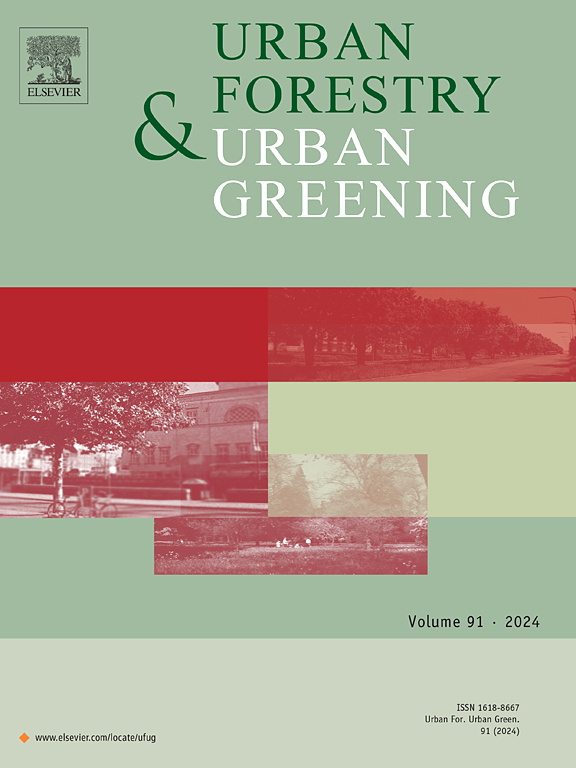The role of university campus landscape characteristics in students’ mental health
IF 6.7
2区 环境科学与生态学
Q1 ENVIRONMENTAL STUDIES
引用次数: 0
Abstract
University students frequently suffer from mental health challenges such as stress, depression, and anxiety during their studies. It is therefore crucial to offer spaces and landscapes on the university campus that offer mental restoration and promote well-being, given the substantial time spent there. Prior research has explored the impact of exposure to campus landscape on students' mental health and the types of spaces that could support activities with potential health benefits. However, further investigation is needed into the specific landscape characteristics that encourage space use and support students’ mental well-being. To address this knowledge gap, we explored how the characteristics of campus outdoor spaces affect students’ preferences concerning spaces they like and dislike to visit, and the subsequent effects on their mental health. We employed a Public Participatory Geographic Information System (PPGIS) approach, focusing on Heriot-Watt University Edinburgh campus in Scotland. Our findings indicate that students exhibit consistent preferences for areas on campus with a high level of greenery, diverse trees and flowers, views of blue spaces, peacefulness, quietness, pleasant smells, and sounds, as well as the presence of benches and tables. These characteristics were also found to facilitate restorative experiences. Conversely, the absence of these elements serves as barriers to students visiting outdoor spaces on campus. The results also revealed that students typically visit their preferred blue/green campus landscapes twice a week for 10–30-minutes on average, which was sufficient to experience the reported mental health benefits as measured through self-reported restorative outcomes. These insights offer valuable implications for the design and development of restorative university campuses.
大学校园景观特色在大学生心理健康中的作用
大学生在学习期间经常遭受心理健康方面的挑战,如压力、抑郁和焦虑。因此,在大学校园内提供空间和景观是至关重要的,因为在那里度过了大量的时间,可以提供精神恢复和促进健康。先前的研究已经探索了校园景观对学生心理健康的影响,以及可以支持潜在健康益处活动的空间类型。然而,需要进一步调查具体的景观特征,以鼓励空间的使用和支持学生的心理健康。为了解决这一知识差距,我们探讨了校园户外空间的特点如何影响学生对他们喜欢和不喜欢的空间的偏好,以及随后对他们心理健康的影响。我们采用了公共参与式地理信息系统(PPGIS)方法,重点研究了苏格兰赫瑞瓦特大学爱丁堡校区。我们的研究结果表明,学生们对校园里绿意盎然、树木和鲜花种类繁多、可以看到蓝色空间、宁静、安静、宜人的气味和声音,以及有长凳和桌子的区域表现出一致的偏好。这些特征也被发现有助于恢复性体验。相反,这些元素的缺乏成为学生访问校园户外空间的障碍。结果还显示,学生通常每周两次平均10 - 30分钟参观他们喜欢的蓝色/绿色校园景观,这足以通过自我报告的恢复结果来体验所报告的心理健康益处。这些见解为恢复性大学校园的设计和发展提供了有价值的启示。
本文章由计算机程序翻译,如有差异,请以英文原文为准。
求助全文
约1分钟内获得全文
求助全文
来源期刊

Urban Forestry & Urban Greening
FORESTRY-
CiteScore
11.70
自引率
12.50%
发文量
289
审稿时长
70 days
期刊介绍:
Urban Forestry and Urban Greening is a refereed, international journal aimed at presenting high-quality research with urban and peri-urban woody and non-woody vegetation and its use, planning, design, establishment and management as its main topics. Urban Forestry and Urban Greening concentrates on all tree-dominated (as joint together in the urban forest) as well as other green resources in and around urban areas, such as woodlands, public and private urban parks and gardens, urban nature areas, street tree and square plantations, botanical gardens and cemeteries.
The journal welcomes basic and applied research papers, as well as review papers and short communications. Contributions should focus on one or more of the following aspects:
-Form and functions of urban forests and other vegetation, including aspects of urban ecology.
-Policy-making, planning and design related to urban forests and other vegetation.
-Selection and establishment of tree resources and other vegetation for urban environments.
-Management of urban forests and other vegetation.
Original contributions of a high academic standard are invited from a wide range of disciplines and fields, including forestry, biology, horticulture, arboriculture, landscape ecology, pathology, soil science, hydrology, landscape architecture, landscape planning, urban planning and design, economics, sociology, environmental psychology, public health, and education.
 求助内容:
求助内容: 应助结果提醒方式:
应助结果提醒方式:


